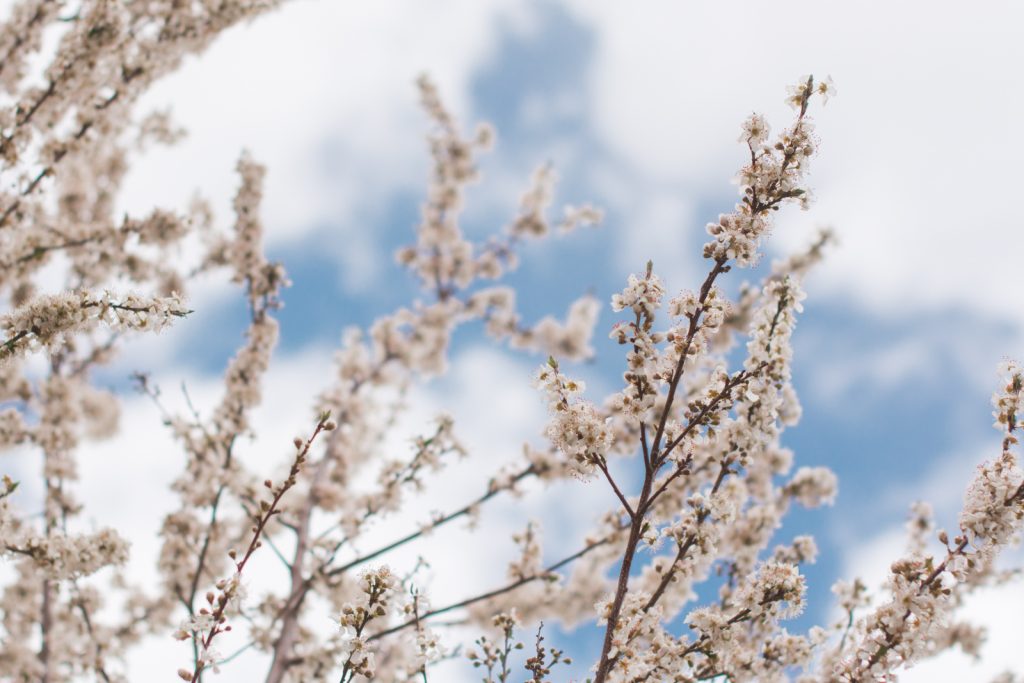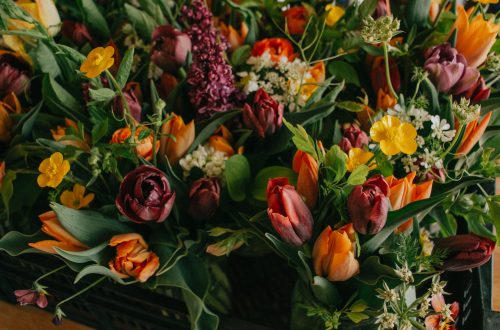
Continuing our month-by-month series, today’s post details all the major tasks on the to-do list for April. Even though winter is (technically) behind us, I always have to prepare myself for a few weather surprises in April, both on the (very) cold side–we’re talking sometimes down into the low teens–and also on the very warm side. April marks the official beginning of our flower farming season to the public since it’s when our first subscription bouquets go out with the first harvested blooms, which are usually daffodils, hyacinths, and early tulips. Out of all the months in our year, April and May seem to always be our very busiest since they combine intensive sowing and transplanting with actual harvesting.
Below is the list of all our expected chores for April.
Note: There may be affiliate links to any products, books, or services mentioned below.
Finish prepping all beds + top with high quality compost
If you’ve been able to get around to all the March to-do’s, you might be lucky enough to already have this one checked off your list, but just in case weather or compost issues have prevented you from checking this one off completely, it will need to be the top priority for April.
Plant bare root roses and lily bulbs
‘Tis the season to plant summer and fall flowering perennials/bulbs, which include bare root roses and lilies. Other examples of plants in this category would be gladioli, crocosmia, astilbe, iris, perennial phlox, etc. Basically most summer flowering blooms grown from bulb or tuber can be planted outside now with the exception of the most frost-sensitive, such as dahlias. A general rule of thumb is if you can leave it safely in the ground over winter in your zone, you’re fine to plant it out in April.
Make sure to prepare the planting area by adding in some high quality compost and removing all weeds, and water the bulbs or bare roots in well after planting at the proper depth.
Note: If you’re planting something that’s NOT dormant (aka, a potted rose instead of a bare root rose), I would personally wait until May to do that.

Plant bare root trees and flowering shrubs
This is also the time to be planting your bare root trees and shrubs, since they’re already dormant and so will appreciate a more gradual acclimation to the warming weather. Many fruit trees make lovely cutting material (I personally love using apple and plum blossoms, and I’m hoping to put in a crabapple tree this year for the foliage, blossoms, and fruit), and some good shrubs to consider for cutting are lilacs, ninebark, viburnum, spirea (this saves me every year), hydrangeas, and quince.
Sow final successions of hardy annuals inside and outside
The window is about to close on actually planting hardy annuals (inside or outside), so make sure you’ve direct sown any you want in the garden by the end of the month and that you’ve started any inside that need growing under cover closer to the first half of the month. Ideally all hardy annuals should be transplanted out or growing no later than early to mid May so that you can try and take some advantage of the cooler temperatures that class of flowers prefers.
Some flower varieties (such as certain kinds of snapdragons) have been bred to handle more heat and longer days and can still be planted out in successions until later May or June, but other hardy annuals such as stock will not bloom at all (or will bloom much, much later in the season) if they’re planted out when the temperatures are too warm. You can always research the issue individually by variety or do an experiment, but your safest bet is usually to have them all planted out no later than about 4 weeks before your last frost date.
Harden off and transplant all previous successions of hardy annuals outside
Along with the above note, you should start transplanting the hardy annual seedlings you started earlier in the season outside to their final locations once you’ve grown them on for the minimum amount of time inside (usually 4-8 weeks). Make sure you harden them off gradually before and that you water them DAILY after transplanting until you start to notice obvious new growth, at which point you can cut down the watering to once every few days (or as needed).
Since I live in a place where our last frost isn’t until early to mid June, I’ve found that April 15 to April 30 is usually my sweet spot to plant out my hardy annuals, but you’ll want to adjust yours accordingly.
Note: If you’re growing in a high tunnel or under frost cloth or some other cover, you’re usually okay to transplant things out a few weeks earlier than the dates mentioned above. I would still advise waiting to do so until you get a stretch when the temperatures aren’t too cold at first (nothing below 28 degrees Fahrenheit or so), and you should still harden the seedlings off before planting them out under cover.

Sow second succession of slow-growing tender annuals (inside)
You should have already started your first succession of some of your slower growing tender annuals (such as china asters, gomphrena, celosia, mahogany splendor hibiscus, etc.), and now it’s time to start your second. Also, if you’re behind the game and haven’t started any of these yet but are planning on growing them, now is the time.
You could still direct sow a few of these outside once the soil warms up (like celosia), but some of the others (like china asters or mahogany splendor), your window is now and likely only now to get these going if you haven’t already.
Sow first succession of quick-growing tender annuals (inside)
Mid to late April is the time to get a head start on all those fast growing tender annuals such as zinnias, cosmos, and marigolds so that you can get blooms from this first succession about a month earlier than any you’d direct sow outside after your last frost. Since these do tend to grow quickly, I recommend starting with a larger size seedling tray (I like using either this size or this size).
Sow first successions of sunflowers inside for an early harvest
My first year of flower farming, I did a big experiment with sunflowers to see how early I could get away with planting them outside and still get blooms since I’d noticed that many self seeded outside much earlier than traditional wisdom tells you to plant them outside. While I did technically get blooms from some of the very earliest sunflowers that I started inside in late March and planted out two weeks later in early April, the blooms were extremely stunted and basically unusable in anything but a boutonniere or flower crown. I’ve had the most success starting them in very early April inside and transplanting them out about 2-3 weeks later. The plants do tend to still be smaller than usual (only about 2-3 feet tall or so), but the blooms are plenty big enough to use in bouquets, and doing this has saved me many a time from the dreaded June gap.
For the record, I only start my ProCut sunflowers this early. For the one branching sunflower variety I favor (“Soraya”), I wait to sow it inside in early May and then transplant it out a couple weeks later.
Also, once I start sowing sunflowers, I basically sow them every week for as long as I can (so, until mid July or so) throughout the season.
Pot up any seedlings that need it
If you have seedlings that have been growing inside for at least 3-4 weeks that already have at least one set of true leaves and that are clearly starting to “fill out” the container they’re in, pot them up into larger containers with fresh potting soil that has ample nutrients and organic fertilizers built in so the plant can continue to grow without stress. (One good budget-friendly option is this organic potting mix, which comes in a more “bulk” size of 1.5 cubic feet. Often organic potting mixes can run you as much as $0.08 an ounce if you buy in smaller quantities, but this brand is rated almost five stars and only costs $0.02 an ounce if you buy this bigger size).
I’ll admit I can be lazy about this one if I know I’m planting out the seedlings within the next week or so, but if I know I still have a few weeks left to go, I’m always glad that I take this extra step, especially since some plants never fully bounce back after being root bound.

Harvest the first of the blooms
April is when you finally start to see the payout from your labors (at least if you put in spring-flowering bulbs the autumn before). April marks the official start of our season, and the blooms we expect this month are hyacinths, daffodils, muscari, and tulips, with overwintered ranunculus and anemones thrown in from the high tunnel. Greenery and filler is hard to come by in April, so like most flower farmers I harvest the tulips by the bulb (for both the stem length and for the foliage) and use their leaves as my main greenery in arrangements. When the trees and shrubs start to blossom by the end of April, those are also used as well.
Stay on top of weeding
Spring is by far the best time to be weeding since the weeds aren’t huge yet and they usually come up pretty easily both because of their smaller size and because the ground is often wet from spring rains or snow. Trust me, your future self will thank you greatly if you don’t put this off until it’s later in the season.

Anything I missed? What are your gardening/flower farming plans for the month?






